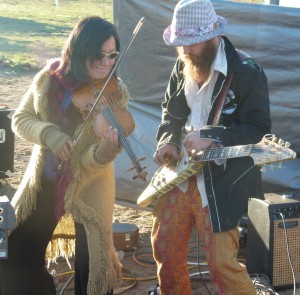 THIS was not a photo on my vision board. I was perfectly content to be performing, showing what I was able to do comfortably, easily, and predictably. I thought I was getting "good" at playing freely, improvising, and creating in the moment. The sound of Chinese Melodrama that matches the stacks of CDs we bring to every gig.
THIS was not a photo on my vision board. I was perfectly content to be performing, showing what I was able to do comfortably, easily, and predictably. I thought I was getting "good" at playing freely, improvising, and creating in the moment. The sound of Chinese Melodrama that matches the stacks of CDs we bring to every gig.
Then THIS had to happen.
By "THIS" I mean: We are at LunarBurn, a three-day outdoor festival and experiment in community living. In my mind, it's a chance to show up and spread the love. We play our first set at the PermaPub, an intimate venue with couches, a bar, and all the impromptu live music one could ask for. We aren’t even finished with a song (Led Zeppelin’s “Over the Hills and Far Away”) near the end of our set, and a guy appears onstage. He has furry white chaps over his jeans, and a grey hoody. He appears to be maybe under the influence of some substances. But what do I even know about these things? I just thought he was a jerk for interrupting our set.
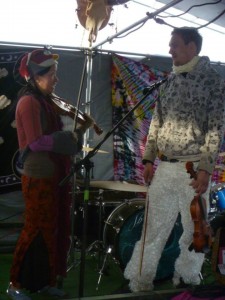
Here’s my, “Get off the stage, jerk!” look:
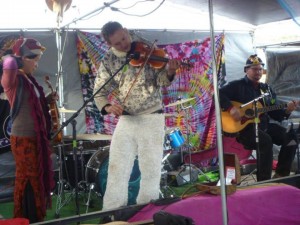
Yep, what you're seeing is a whole lotta judgment flowing freely from me in that moment. First he wanted to play my violin. I’d rehearsed this response before, so it was easy to say, “Sorry, I don’t let anyone touch my violin.”
He wasn’t looking like he was going to leave the stage, and this being an open, community-driven atmosphere, I said, “You can play yours, and I’ll play mine.”
Then he wanted me to help him tune the thing.
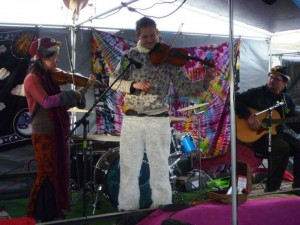
Seriously??? Suddenly I was flung back to my violin school, “Doctor Chu” days, tuning other people’s violins. Spooky.
My partner Randy was way too far away on the other end of the stage, separated from me by a drumset. I was alone to deal with this. But when it was clear that The Guy – Adam, I would later learn, was his name - was there to stay and play, Randy pulled out the right song – like he always does -- and that was all it took.
Adam started to play. All kinds of sounds were flying out of his instrument, no holds barred. Absolutely no judgment.
I’d never heard such sounds before, let alone play with them, try to create with them. But there I was, on a stage, with captive audience, and microphones on. I started to play too. The interplay of sound and listening began to work its magic. Then moments emerged from the chaos that felt like oneness.
Really? With THIS jerk? Yes.
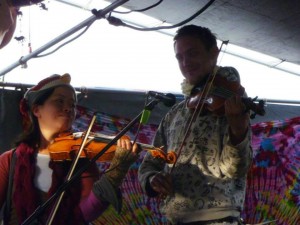
I was listening to all the sounds, noticing, admiring, perhaps sometimes even envying, the beauty that can arise from NOT CARING AT ALL, in other words, no judgment.
You must understand how deeply ingrained it is for me to take GREAT CARE of every sound from my violin. I’ll never forget sitting in a huge auditorium in Chicago watching one of the “big kids” – a high-schooler at the time – in my violin school, receiving a master class with Russian violinist Viktoria Mullova. I was about 10 years old.
“You don’t CARE!”, she said, in a thoroughly Russian, loving way. It was the kind of icy cold Russian love so commonly doled out in violin training. Meanwhile my classmate’s lips trembled, tears beginning to well up behind her eyes. Tears that represented a lifetime, from the age of three, trying so hard to prove that she cared. She was one of the stars, one of the protected ones in the group. No one had ever spoken to her like that. At least not in public. On a stage. In front of other people.
I vowed never to play like I didn’t care, if only to avoid the stinging feeling I felt that day.
So to stand on my stage with this guy – Adam – who had the audacity to walk in on us and just PLAY like he doesn’t CARE was a big moment. A moment either to shut down or to wake up and say yes to life. Shutting down occurred to me for a few moments. Remember this face?

Yeah, I was ready to shut it down. But then I remembered that I could just relax into my own place that doesn’t care so much. The place that knows I can play anything with anyone and I will be OK. The place of trust and surrender.
Because when you don’t care, you really are trusting in something greater than personalities and performances. Somewhere along the way, in our journey of recording and performing and trying to “build” something with Chinese Melodrama, I got caught up (again) in making things beautiful and perfect and acceptable and nice. I got caught up in my idea of what “good” sounds like. What I had to measure up to (in my own mind) in order to be worthy of appreciation, applause, presence, whatever. My idea of what I needed to be in order to be liked and accepted.
What I experienced by not caring so much was another layer of freedom peeled away and revealed to me. The discovery of something workable – beautiful – within the basket of sounds I’d call “dirty”. The sounds I don’t choose automatically because of the depth of my conditioning to play only beautifully. The discovery that he will never sound like me, and I will never sound like him, so there is nothing to fear. We can meet in the oneness of our combined sounds and play. Dance. Listen. See what happens.
“Beyond our ideas of right-doing and wrong-doing there is a field. I’ll meet you there. When the soul lies down in that grass, the world is too full to talk about.” – Rumi
The next day, I returned to the stage with Randy. No Adam this time. Yet I still had the taste of the experience in my body, my ears, my whole being. I carried the permission of those “dirty” notes with me. They gave me wings to be less careful, more adventurous, more willing to be curious without worrying I would hurt or disappoint anyone. I had fun. I moved more. I felt my own joy. I invited it in. I was inspired by "no judgment".
I noticed that as I became more playful, my entire body began to participate. My feet were not firmly planted on the floor with my legs stable. My knees began to bend. My spine began to twist and turn. My feet were walking (sometimes stomping). My head was leaning. The feelings of the music flowed through my entire being, when my mind was no longer involved in saying, “Now what can I play that will be really beautiful?”.
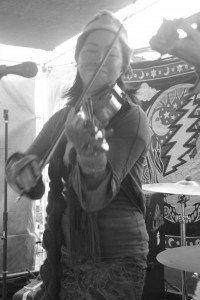
When the music becomes a dance, when I am truly playing, then it’s not about what the notes are, but what is going on inside me as I am playing them. Even if I play every single note “beautifully”, correctly, in tune, like I was taught, it may not connect with a feeling. Because I may actually be trying very hard to create this state of “beautiful” and “correct”. Within me, I am not playful. I am controlling myself. When I am controlling myself, I radiate the energy of control.
When I lose control, anything can happen. Scary, yes. But on the other side of scary, there is beauty. Not “beautiful”, but beauty. The beauty of anything and everything. The beauty of what is.
P.S. Thank you so much to Adam, Matty, and everyone at LunarBurn who played and listened!
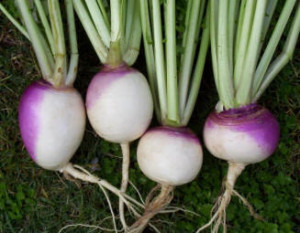
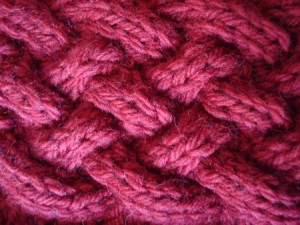 In The Wisdom of No Escape, there's a chapter where Pema Chodron talks about three useful qualities for life and for meditation: precision, gentleness, and letting go.
In The Wisdom of No Escape, there's a chapter where Pema Chodron talks about three useful qualities for life and for meditation: precision, gentleness, and letting go.


 THIS was not a photo on my vision board. I was perfectly content to be performing, showing what I was able to do comfortably, easily, and predictably. I thought I was getting "good" at playing freely, improvising, and creating in the moment. The sound of
THIS was not a photo on my vision board. I was perfectly content to be performing, showing what I was able to do comfortably, easily, and predictably. I thought I was getting "good" at playing freely, improvising, and creating in the moment. The sound of 




 There's going to be some talk about
There's going to be some talk about 